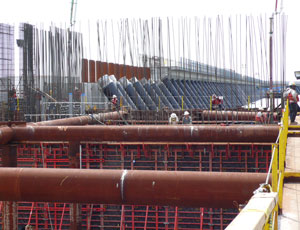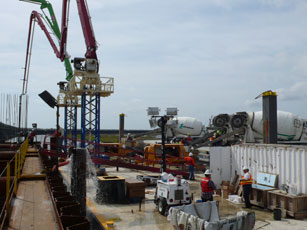Several months ahead of schedule and less than a year after driving the first 66-inch concrete cylinder pile, Shaw Environmental & Infrastructure Group is rapidly completing a 7,490-ft.-long storm-surge protection wall that is the central part of a roughly two-mile long surge barrier in New Orleans.


The placement of a significant portion of the barrier, well ahead of the start of the 2010 hurricane season, adds a welcome level of defense on the city’s eastern flank.
The U.S. Army Corps of Engineers is pushing for speedy delivery of the $1.3 billion Lake Borgne Inner Harbor Navigation Canal Storm Surge Barrier to reinforce what is often called the Achilles heel of the city’s hurricane and storm damage risk reduction system.
Shaw, of Baton Rouge, La., is responding with an aggressive effort.
“Everybody is pleased with the progress,” says Ron Elmer, Corps IHNC project manager. “We get nothing but positive feedback, and we’re on schedule for the whole project to meet the June 1, 2011 date.”
The contract was awarded April 2008.
"We drove the first vertical pile May 2009, and the last batter pile was driven April 10,” says Charlie Hess, senior vice president, Shaw Environmental and IHNC project manager. He called the performance “phenomenal...unprecedented” in terms of civil works.
Shaw’s subcontractors — Manson Construction Co., Seattle, Wash. and TMW, a joint venture of Traylor Bros. Inc., Evansville, Ind.; Massman Construction Co., St. Louis, Mo. and Weeks Marine, Cranford, N.J., — are expected to continue on finishing touches to the wall and on construction of other features of the surge barrier for several more months.
The barrier also includes a sector gate with a bypass barge gate, a navigable sector gate and rock-reinforced T-wall-style floodwalls. But having the central portion in place ahead of schedule is “clearly a major milestone” in the overall program, Hess says.
Officials say that, although it is difficult to determine the exact level of protection provided by the wall with other components not yet complete, significantly more protection is in place than when Hurricane Katrina’s surge barreled through this area in 2005, flooding eastern New Orleans, the lower ninth ward and St. Bernard Parish.
The wall is more than 90% in place, so it provides +26 ft. of protection except where the caps and parapet walls have yet to be installed, Elmer says. Cofferdams are in place for sector gates, and those will provide +8 ft. of protection.
“To try and determine whether that translates into 20-, 30- or 40-year levels of protection would be difficult to do because we have little spots we’d have to run through hydrology models,” Elmer says.
By March 29, TMW was 94% complete on installation of batter piles, says Victor Zillmer, Corps resident manager on the IHNC surge barrier. “We have installed 67% (229) caps and 51% (3,918 ft.) of parapet wall,” Zillmer says. TMW had also installed 15 of 17 expansion joint pile pairs and 4 of 17 pairs of expansion joint caps. “We expect the braced wall to be substantially complete on 4 July,” Zillmer says.
In early April, Manson completed a 475-cu-yd concrete pour, the last large casting for the barge gate. Dredging east of the barge gate was 75% complete and expected to finish within the two weeks.
Rock and sand fill work is nearly complete and work is moving briskly on construction of tie-in concrete T-walls on both the north and south end of the project. Activities are expected to wrap up nearly every week, for the next few months, Zillmer says.
Despite the pace and complexity, and with 32 cranes and 364 people working round the clock, the Corps reported only two lost-time incidents (one this fiscal year and one the last) for 1.4 million hours of work, says Sherry Scott, safety director for the Corps Hurricane Protection Office.
TMW’s three JV partners expect be finished, demobilized and offsite with all equipment by July, says Wayne Jones, TMW project manager. In early April, several of the larger cranes had already been moved dockside in preparation for demobilization.
“We will still be placing caps into the summer, and work on the gates will go on through the 2011 completion,” Hess says. “Obviously, until the whole thing is complete, there are still vulnerabilities out there,” he adds. “The job is not over until it’s over, and we’re keeping our eye on the prize. But we’re looking forward to finishing this up in short order and doing more work.”
But elsewhere in the web of linked waterways lacing the area, vulnerabilities still remain and contractors working to work to address them have much to do.
At the north end of the IHNC, Alberici Constructors, Overland, Mo. is just getting started on an estimated $155-million surge barrier at the Seabrook Bridge. The Corps awarded Alberici the $495,000 base portion of an early contractor involvement contract in October, and is working with Alberici to speed up installation of a cofferdam to provide some level of protection there.
“Surge coming into the lake will affect the interior of the canal,” Elmer says. However, the Corps has strengthened canal walls with reinforcements including rip rap, sheet pile seepage cutoffs, relief wells and soil mixing. It hopes to have the cofferdam under construction by summer.

Post a comment to this article
Report Abusive Comment